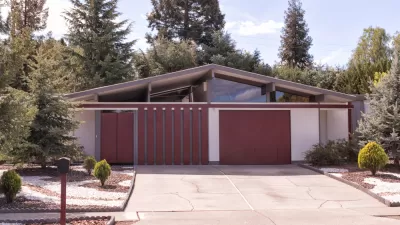A Wall Street Journal trend piece argues that a shift toward luxury apartments in cities across the United States is driving up the cost of rent throughout the market.

Laura Kusisto notes that developers are building more luxury multi-family units than any other multi-family residential typology:
"Of 370,000 multifamily rental units completed from 2012 to 2014 in 54 U.S. metropolitan areas, 82% were in the luxury category, according to CoStar Group Inc., a real-estate research firm. The firm defines luxury buildings as those that command rents in the top 20% of the market. In some places, including Denver, Tampa, Baltimore and Phoenix, virtually all new apartment construction has been targeted to high-end renters. In Atlanta, about 95% of new apartments have been in the luxury category."
According to the article, in the past such building booms at the upper end of the market would have alleviated demand for older buildings, and by extension, lowering the cost of the middle of the market. According to Kusisto, "[that] pattern isn’t occurring in the current cycle, say economists, due in part to a supply shortage."
As that sentence implies, the article mixes rhetoric with its reporting. By the conclusion of the article, Kusisto explicitly recommends a supply-side action to mitigate the trend of rising rents:
"Cities should also look at loosening many of the zoning and other regulatory restrictions that make development so costly and lengthy and have kept rates of new rental construction low in many places, experts said. Allowing developers to build smaller, micro-units, can also help keep rents more affordable to young professionals."
FULL STORY: New Luxury Rental Projects Add to Rent Squeeze

Maui's Vacation Rental Debate Turns Ugly
Verbal attacks, misinformation campaigns and fistfights plague a high-stakes debate to convert thousands of vacation rentals into long-term housing.

Planetizen Federal Action Tracker
A weekly monitor of how Trump’s orders and actions are impacting planners and planning in America.

In Urban Planning, AI Prompting Could be the New Design Thinking
Creativity has long been key to great urban design. What if we see AI as our new creative partner?

Portland Raises Parking Fees to Pay for Street Maintenance
The city is struggling to bridge a massive budget gap at the Bureau of Transportation, which largely depleted its reserves during the Civd-19 pandemic.

Spokane Mayor Introduces Housing Reforms Package
Mayor Lisa Brown’s proposals include deferring or waiving some development fees to encourage more affordable housing development.

Houston Mayor Kills Another Bike Lane
The mayor rejected a proposed bike lane in the Montrose district in keeping with his pledge to maintain car lanes.
Urban Design for Planners 1: Software Tools
This six-course series explores essential urban design concepts using open source software and equips planners with the tools they need to participate fully in the urban design process.
Planning for Universal Design
Learn the tools for implementing Universal Design in planning regulations.
Gallatin County Department of Planning & Community Development
Heyer Gruel & Associates PA
JM Goldson LLC
City of Camden Redevelopment Agency
City of Astoria
Transportation Research & Education Center (TREC) at Portland State University
Jefferson Parish Government
Camden Redevelopment Agency
City of Claremont





























